Everyone knows the tiger, the panda, the blue whale, but what about the other five to thirty million species estimated to inhabit our Earth? Many of these marvelous, stunning, and rare species have received little attention from the media, conservation groups, and the public. This series is an attempt to give these ‘forgotten species‘ some well-deserved attention.
.600.jpg)
The tufted ground squirrel (Rheithrosciurus macrotis) caught on camera trap in Kalimantan, Indonesian Borneo. Outside camera traps, few photos of this species exist. Photo by: Erik Meijaard.
To residents of the Northern Hemisphere, the squirrel is arguably the most mundane mammal. It’s a good bet that no mammal is more likely to be encountered when you walk out your door than a member of the Sciuridae family. In fact I can look out my front window right now in a city of 3.4 million and probably see at least one, if not two or three, squirrels. Try that with any other mammal and I guarantee you’ll fail the majority of the time. Sure, mice and rats may also be ubiquitous, but they are generally ubiquitously cryptic, hiding in places we can’t see. Squirrels are unabashedly brazen.
It’s not surprising then that many people begrudge squirrels as nuisance animals: they gorge themselves on bird feeders with audacity, they build nests in attics, they chew on power lines, and in some cases can even create fire hazards. Yet if we are honest with ourselves, we have a lot in common with these highly adaptable species. They are as at home in urban areas as the countryside and the forest. They deftly manipulate their environment and have perfected the art of storing food for the long-term. While technically a quadruped, squirrels can use their forelegs adeptly, easily manipulating much of what they get their “hands” on. They are as acrobatic as any mature circus performer, constantly doing gravity-defying acts. And just like humans, various species of squirrels are found in pretty much every environment but the high Arctic and Antarctic. Perhaps with another few million years of evolution, big-brained, large-bodied squirrels could become the new dominant mammal on Earth.
But not all squirrels can be seen outside your front door. In fact only a few squirrel species—out of the nearly 300 in Sciuridae including chipmunks, prairie dogs, and even marmots—have readily urbanized. Many stick to deserts, grasslands, mountains, and even hot, humid rainforests.
In fact, arguably, the world’s most exotic squirrel comes from just such a rainforest: the tufted ground squirrel (Rheithrosciurus macrotis).
An exotic squirrel and a super tail
.600.jpg)
Tufted ground squirrel showing off that big tail. Photo by: Integrated Conservation.
Now, admittedly, its name isn’t very exotic. But new research by a 15-year-old scientist, Emily Meijaard, has helped mark this species as truly bizarre.
Let’s start with these facts: the tufted ground squirrel is only found in the deep rainforests of Borneo, a island better known for orangutans, pygmy elephants, and Sumatran rhinos than squirrels. It’s both threatened with extinction and almost wholly unknown to science. And, as Emily Meijaard’s research proves: the tufted ground squirrel may well have the biggest tail compared to body size of any mammal on the planet.
“After looking at some camera trap photos and seeing the monstrous tail of this creature we decided it needed some further research,” explained Emily Meijaard to mongabay.com, who is currently attending the British International School-Jakarta.
“We looked at various other animals with large or fluffy tails and we then realized that the tufted ground squirrel had one of the largest tails compared to the size of its body.”
Meijaard wrote the paper with the help of her scientist-parents, Erik Meijaard and Rona Anne Dennis. It was published recently in Taprobanica.
 Tufted ground squirrel on camera trap. Photo by: Erik Meijaard. |
“Growing up in a family full of scientists I obviously have an interest in the subject,” she said. “My father also always says that anything is publishable you just have to make it interesting and get it out in the right place.”
The findings certainly are interesting! The researchers determined the tufted ground squirrel’s tail was in fact 130 percent the size of its body. None of the other mammals surveyed even broke the 100 percent threshold. For example, the spotted skunk’s tail is only 35 percent the size of its body while the red squirrel’s tail comes in at 90 percent. Common across Europe and northern Asia, the red squirrel (Sciurus vulgaris) uses its tail for balance, warmth, and steering.
But why did the tufted ground squirrel evolve a tail so much bigger than its northern relative?
“No one has studied the behavior of the species so we can only guess,” answered Emily Meijaard.
Her research discarded a few theories, such as thermoregulation (it doesn’t get cold enough in these jungles), balancing (as its name suggests this squirrel spends most of its time on the ground), and attracting a mate.
“The tail could play a role in sexual behavior, although we noted that apparently both males and females have the same large, extremely fluffy tail,” she said.
But, one theory survived initial scrutiny.
“Our best guess is that the tail has an anti-predation mechanism,” Emily Meijaard noted. “In pursuit, a predator would likely strike at the large fluffy bush rather than the squirrel’s body, possibly giving it a chance to get away.”
In fact, one can see how much sense this makes just by looking at a photo of the animal; the eye seems to catch the tail before it makes out the squirrel. The tail, which in many photos sticks straight up, practically dwarfs the diminutive squirrel beneath.
A number of predators may target the squirrel (or it’s misleading tail as the case may be): the biggest is the Sunda clouded leopard (Neofelis diardi), but there’s also the bay cat (Catopuma badia), the marbled cat (Pardofelis marmorata), and possibly the yellow-throated marten (Martes flavigula) and the Malay weasel (Mustela nudipes).
Still, Emily admitted, “it will be hard to get some good evidence for our theory though.”
Bloodsucking squirrel?
.600.jpg)
Tufted ground squirrel on camera trap. Photo by: Integrated Conservation.
According to stories from locals, the tufted ground squirrel can take of itself, big tail or no. In fact, if even a shadow of the following stories prove true, a more “accurate” name for the tufted ground squirrel might be: the blood-sucking, throat-slitting, disemboweling squirrel.
“There is a relatively rich animal folklore regarding [the tufted ground squirrel],” the scientists write in the paper. “People of Borneo have traditionally hunted the species for meat and ornamental use of its tail, among others to adorn machetes.”
But then things get very interesting: “remarkably for a squirrel, forest-dwelling people consider this squirrel to be quite fierce,” the researchers write.
Fierce may be an understatement. A local hunter told Rona Anne Dennis that he once observed the squirrel takedown a common muntjac (Muntiacus muntjak). Although a small deer, a muntjac can still weigh up to 28 kilograms (over 60 pounds).
 Tufted ground squirrel on camera trap. Photo by: Integrated Conservation. |
“On asking how a squirrel could kill a large animal such as a [muntjac], the response was that the squirrel waits on a low branch for a deer to pass below, jumps on its back and bites the jugular vein, whereon the deer bleeds to death,” the researchers write. “Once dead the squirrel proceeds to disembowel the deer and eat the stomach contents, heart and liver. Dayak hunters sometimes find these disemboweled deer in the forest, none of the flesh eaten, which to them is a clear sign of a squirrel kill.”
Apparently the squirrel doesn’t just hunt wild game, but also kills village chickens, devouring “the heart and liver only.”
While such stories sound implausible, it’s important to note that local knowledge of wildlife often turns out to be true, at least in part. And meat-eating squirrels aren’t wholly unknown. In fact, the cream-colored giant squirrel (Ratufa affinis), which is also found in Borneo, is believed to “actively hunt birds and other vertebrates,” according to the study. The thirteen ground-lined squirrel (Ictidomys tridecemlineatus), common in parts of North America, has been known to eat small animals like mice and shrews. There are also anecdotal reports of many squirrel species eating meat when the opportunity arises.
The twisted evolutionary path of Borneo’s tufted ground squirrel may also explain some of its distinctness. Bizarrely, its nearest relatives are not found in Asia, or even Europe or Africa. In fact, the tufted ground squirrel’s closest relatives are in South America.
“The evolutionary lineage…must have once spread from South America through mainland Asia and into Borneo, after which all its Asian relatives died out,” said Emily Meijaard. “Why that happened we don’t know.”
The researchers theorize, however, that the wealth of big predators on mainland Asia—including tiger, dhole, and leopard—may have played a role in pushing its relatives to extinction. Other squirrels on the continent are arboreal, allowing them to escape these predators by heading into the trees.
The tufted ground squirrel may have survived on Borneo because it had fewer big predators to fear, according to the scientists. Perhaps its reputed fierceness also helped.
An endangered squirrel

Aerial view of deforestation for palm oil in Borneo. Photo by: Rhett A. Butler.
It’s easy to imagine squirrels as among the most common mammals on the planet, but that’s a misconception. Of the 273 species recognized by the IUCN in the Sciuridae Family, 33 are currently considered threatened with extinction and another 28 are listed as Near Threatened. But perhaps, most surprising of all is that 39 of the species are listed as Data Deficient, meaning scientists don’t even have enough information to determine whether the species is imperiled or not. As to our subject, it’s listed as Vulnerable.
“The tufted ground squirrel occurs primarily in lowland and hilly forest on Borneo, and these forests are disappearing rapidly,” Emily Meijaard said.
Indeed, a recent paper—including Erik Meijaard as co-author—found that Borneo has lost over 30 percent of its forest cover since 1973. Worse still, the island lost 73 percent of its intact lowland forests to logging or clearance during the same period. A generation ago, the island was still one of the wildest spots on the planet; today many of its well-known animals are threatened with extinction due to widespread logging and oil palm plantations.
“There may also be additional pressure from hunting and indiscriminate snaring of wildlife, which is rampant on Borneo…[The tufted ground squirrel] is indeed rarely seen, but in most forested places on Borneo where people are camera trapping it, it is confirmed,” explained Emily Meijaard, adding, “it has not yet been recorded in peat swamp forests though.”
While the scientists hope their paper—and this little-known animal—will help draw more attention to the plight of Borneo’s biodiversity, they also worry that drawing attention to the squirrel could, in fact, make matters worse.

Painting of tufted ground squirrel from 1855. This was likely done from a specimen brought back from Borneo, hence the fact that the tail is considerably smaller than in life. Illustration by: Joseph Wolf.
“There is a tremendous amount of animal collecting going on in Borneo, for food, the pet trade and other reasons,” Emily Meijaard explained. “This also includes squirrels, with especially the smaller flying squirrels having recently become popular as pets. The last thing we want is that the international attention to the tufted ground squirrel will increase the demand for the species, from private collections or from zoos.”
Emily added that they were surprised by the amount of press the squirrel has already received with popular stories in both Science and Scientific American.
“There is always a difficult balance between seeking publicity for a conservation cause and keeping things silent,” she noted.
Even though bringing attention to the species might backfire, it must also be noted that there are currently no conservation programs directly targeting the species nor are there any scientists studying it. Hopefully, a bigger profile will help the species gain some conservation champions.
“The tufted ground squirrel would make a great subject for a wildlife biology student. It wouldn’t be an easy species to study, because it is quite elusive while its terrestrial behavior would make it harder to observe than arboreal species,” said Emily Meijaard. “Radio collaring a few animals might provide insight into its ranging patterns, while detailed camera trapping could reveal more about its behavior. A good study should ideally also include interviews with local people to better understand how often the species is hunted or trapped, and also what aspects of the species people have observed.”
Despite the number of wild stories about the tufted ground squirrel, the researchers write that they “keep an open mind” on what future research of this decidedly un-mundane squirrel will reveal.
.600.jpg)
Tufted ground squirrel showing off that big tail. Photo by: Integrated Conservation.
“After all, another seemingly unlikely hunter story from Borneo of [mouse deer] hiding underwater for long periods of time also turned out to be true,” the researchers write. “Such finds reiterate how little we know about Bornean wildlife, and [the ground tufted squirrel] is only one among many fascinating species on this remarkable island requiring our attention as scientists and conservationists.”
As to lead author, 15-year-old Emily Meijaard, she’s not certain what her future will hold.
“I don’t have a clear plan on what I am going to do when I am older, but I do know that it will be something science related,” she said. “I have a particular interest in biology, physics and geography…Subject areas that I have thought about are marine biology, bioanthropology, marine bioanthropology, sport science.”
Whatever she decides, her efforts have already helped shed light on a species too long left to the rainforest shadows.
And next time you see a ubiquitous squirrel in your front yard—raiding your birdfeeder or gnawing on your tree—give a thought to the many exotic squirrel species around the world, some of which are facing down extinction… And one which may be hunting deer with a ridiculous boldness that we humans should well recognize.
Citations:
- Meijaard, Emily Mae, Rona Anne Dennis, and Erik Meijaard. “Tall Tales of a Tropical Squirrel.” TAPROBANICA: The Journal of Asian Biodiversity 6, no. 1 (2014): 27-31.
Related articles
Forgotten species: the nearly extinct primate that can be shot on sight

(09/27/2013) The attention paid to charismatic popular primates—such as gorillas, chimps, orangutans, lion tamarins, and even some lemurs—could make one suppose that conservationists have the protection of our closest relatives well in hand; the astounding fact that no primate species is known to have gone extinct in the last hundred years (despite large-scale destruction of their habitats) seems to confirm this statement. However, looking more closely at the data, one finds that not only are many of the world’s primates slipping toward extinction, but a number of them have received little conservation attention. According to the IUCN Red List, a staggering 48 percent of the world’s primates are threatened with extinction: that’s a worse percentage than amphibians which have been ravaged by a global epidemic. And although a handful of the world’s 600-plus primates have garnered conservation adoration, many remain obscure.
Forgotten species: the arapaima or ‘dinosaur fish’

(07/15/2013) Let’s go back some 14,000 years (or up to 50,000 depending on who you talk to), since this is the first time humans encountered the meandering, seemingly endless river system of the Amazon. Certainly, the world’s first Amazonians would have been astounded by the giant beasts of the region, including ground sloths and mastodons (both now extinct), as well as giant anteaters, armadillos, and tapirs, currently the biggest land animal on the continent. But these first explorers might have been even more surprised by what dwelled in the rivers: anaconda, caiman, and the arapaima. Wait, the what?
Forgotten species: the overlooked Sumatran striped rabbit
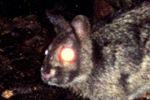
(06/28/2012) When you read the words ‘Sumatra’ and ‘Endangered Species’ in the same sentence there is a 99 percent chance that you will be reading about one of four animals: orangutans, tigers, elephants, or rhinos. These big four of Sumatra have become the rallying cry to save the island’s ever-dwindling forests. This is not surprising, given that these species include some of the world’s most publicly beloved animals and, in addition, they are all considered Critically Endangered by the IUCN Red List. But by dominating the headlines in Sumatra’s deforestation crisis, these four species often overshadow the thousands of other species found on the island, many of which also face extinction. In fact when you read the words ‘Sumatra’ and ‘Endangered Species’ you will almost certainly not be reading about the Sumatran striped rabbit.
Forgotten Species: the wonder-inducing giant clam
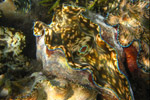
(06/11/2012) The first time I ever saw a giant clam was at a ride in Walt Disney World’s Magic Kingdom. My family and I piled into the Nautilus submersible at the 20,000 Leagues Under the Sea: Submarine Voyage and descended into the playtime depths. While we saw sea turtles, sharks, lobsters, mermaids, and even a sea monster, the creature that lingered in my mind most was the giant clam, raising and closing its pearly shell in the weedy abyss. Of course, none of these aquatic wonders were real—they were animatronics—but to a child with a vivid imagination they stirred within me the deep mystery of the boundless ocean, and none more so than that monstrous clam with its gaping maw.
Forgotten species: the wild jungle cattle called banteng
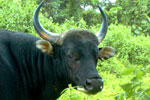
(01/31/2012) The word “cattle,” for most of us, is the antithesis of exotic; it’s familiar like a family member one’s happy enough to ignore, but doesn’t really mind having around. Think for a moment of the names: cattle, cow, bovine…likely they make many of us think more of the animals’ byproducts than the creatures themselves—i.e. milk, butter, ice cream or steak—as if they were an automated food factory and not living beings. But if we expand our minds a bit further, “cattle” may bring up thoughts of cowboys, Texas, herds pounding the dust, or merely grazing dully in the pasture. But none of these titles, no matter how far we pursue them, conjure up images of steamy tropical rainforest or gravely imperiled species. A cow may be beautiful in its own domesticated sort-of-way, but there is nothing wild in it, nothing enchanting. However like most generalizations, this idea of cattle falls to pieces when one encounters, whether in literature or life, the banteng.
Forgotten species: the rebellious spotted handfish
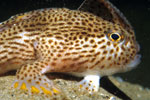
(07/12/2011) Evolution is a bizarre mistress. In her adaptation workshop she has crafted parrots that don’t fly, amphibians with lifelong gills, poison-injecting rodents, and tusked whales. In an evolutionary hodge-podge that is reminiscent of such mythical beasts as chimeras and griffins, she has from time-to-time given some species’ attributes of others, such as the marine iguana who is as happy underwater as a seal, the duck-billed platypus that lays eggs like a reptile, and the purple frog that has a lifestyle reminiscent of a mole. Then there’s one of her least-known hodge-podges: the fish who ‘walks’ with hands instead of swimming.
Forgotten species: the endearing Tenkile tree kangaroo
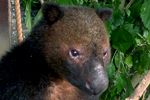
(05/03/2011) With their long snout, furry body, soft eyes, and, at times, upright stance, tree kangaroos often remind me of the muppets. Of course, if there were any fairness in the world, the muppets would remind me of tree kangaroos, since kangaroos, or macropods, have inhabited the Earth for at least 5 million years longer than Jim Henson’s muppets. But as a child of the 1980s, I knew about muppets well before tree kangaroos, which play second fiddle in the public imagination to their bigger, boxing cousins. This is perhaps surprising, as tree kangaroos possess three characteristics that should make them immensely popular: they are mammals, they are monkey-like (and who doesn’t like monkeys?), and they are desperately ‘cute’.













